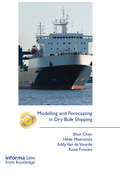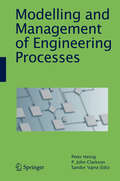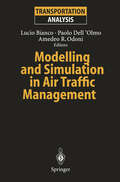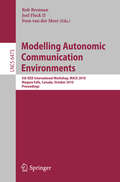- Table View
- List View
Modellierung und Ausführung von Workflows mit Petri-Netzen (Teubner Reihe Wirtschaftsinformatik)
by Andreas OberweisModellierung und Bewertung von Kreditrisiken (Beiträge zur betriebswirtschaftlichen Forschung #105)
by Peter GrundkePeter Grundke vergleicht die Bewertungsergebnisse verschiedener Ansätze zur Bestimmung risikoadäquater Preise für ausfallbedrohte Finanztitel. Er analysiert zudem ratingbasierte Bewertungsmodelle, entwickelt realitätsnähere Modellvarianten und bewertet innerhalb dieser zahlreiche Kreditderivatformen. Um die Unterschätzung unerwarteter Verluste eines Kreditportfolios zu vermeiden, verknüpft er darüber hinaus ratingbasierte Bewertungsmodelle mit im Risikomanagement verwendeten Kreditportfoliomodellen.
Modellierung von Abhängigkeitsstrukturen durch Copulas: Theorie und Anwendungen in der Risikotechnik
by Klaus J. SchröterIn diesem Buch lernen Sie die Vielfalt der Wechselwirkungen von Zufallsvariablen und unterschiedliche Ansätze ihrer theoretischen Beschreibung kennen. Im Fokus der Betrachtungen steht der Einsatz von Copulas; Sie lernen gezielt mit diesen zu operieren. Sie erfahren zunächst anhand umfangreicher Resultate und zahlreicher Beispiele, welche Ausprägungen von Abhängigkeitsstrukturen mit welchen Eigenschaften von Copulas korrespondieren. Anschließend lernen Sie ausgewählte Anwendungen der zuvor bereitgestellten Erkenntnisse kennen, die meist aus der Versicherungstechnik stammen. Sie erhalten beispielsweise einen Einblick in die speziellen Abhängigkeitsstrukturen in den Modellen der Erfahrungstarifierung. Eine Besonderheit stellt der Umgang mit Summen abhängiger Zufallsvariablen dar: Sie erfahren, wie auch ohne Vorliegen der häufigen Annahme der Unabhängigkeit die Verteilung der Summen bestimmt werden kann. Die Anwendungen und Untersuchungen werden zumeist durch Simulationen und Punktwolken illustriert.
Modellierung von Investorenverhalten: Implikationen für interkulturelles Investor Marketing und Investor Relations (Integratives Marketing - Wissenstransfer zwischen Theorie und Praxis)
by Martin ReimannMartin Reimann verknüpft kulturelle Wertekonstrukte und intrapersonale Verhaltenskonstrukte, unterzieht sie einer kausalanalytischen Untersuchung und stellt sie im Rahmen von Partialmodellen des kulturell bedingten Investorenverhaltens dar. Er leitet Implikationen für interkulturelle Investor Relations ab und erarbeitet eine qualitative Basis für eine differenzierte Kommunikation zwischen Investor-Relations-Managern und Investoren.
Modellierung von Kommunikationsprozessen in KMU-Netzwerken: Grundlagen und Ansätze
by Jens SchützeKleine und mittlere Unternehmen haben eine enorme Bedeutung für die Entwicklung sowohl der deutschen als auch der europäischen Wirtschaft. Zur Sicherung ihrer Wettbewerbs- und Zukunftsfähigkeit bei sich ständig verändernden Marktbedingungen versuchen viele KMU, ihre betriebliche Entwicklung durch Kooperationen mit anderen Unternehmen zu verbessern. Die dabei entstehenden Unternehmensnetzwerke müssen wachsen und aus sich heraus ihr Fortbestehen sichern, um die Vorteile einer Kooperation nachhaltig zu nutzen. Insofern kommt den Kommunikationsprozessen zwischen vernetzt agierenden Unternehmen eine besondere Bedeutung zu. Umso verwunderlicher ist es, dass man sich bei der Vernetzung von Unternehmen zwar sehr intensiv der Gestaltung der materiellen und informationstechnischen Prozesse widmet, aber die Kommunikation aus den Betrachtungen solcher Netze weitgehend eliminiert. Die Bedeutung der Kommunikation wird nicht unterschätzt. Es kommt aber dem Autor der vorliegenden Arbeit zu, mit einem neuartigen wissenschaftlichen Ansatz eine Methode entwickelt zu haben, um genau diese Prozesse modellieren zu können. Vor diesem Hintergrund erfolgt eine systematische Analyse verschiedenster Kommunikationstheorien und -modelle, in deren Ergebnis einerseits der Begriff der Kommunikationsartefakte eingeführt wird und andererseits eine Vielzahl von Kommunikationsartefakten als potenzielle Modellierungselemente für kommunikative Aspekte beschrieben werden. Damit ist der Versuch, im Rahmen einer ingenie- wissenschaftlichen Arbeit die erkenntnistheoretischen Grundlagen der analysierten Kommunikationstheorien und -modelle zu diskutieren, mit nötigem Respekt gelungen. Bei der Auswahl einer Basismodellierungsmethode gelang es, einen umfassenden Überblick über bekannte Methoden und Sprachen der Geschäftsprozessmodellierung zu geben. Besonders hervorzuheben ist die zusammenfassende Darstellung und Würdigung von Merkmalen und Eigenschaften in Matrizen, die systematisch dazu führt, UML als Basismodellierungsmethode zu begründen.
Modellierung von OLAP- und Data-Warehouse-Systemen
by Andreas TotokAuf Basis von Data-Warehouse- und OLAP-Konzepten analysiert Andreas Totok multidimensionale Controllinginformationssysteme sowohl aus informationstechnischer als auch aus betriebswirtschaftlicher Perspektive mit dem Ziel der Verknüpfung beider Sichtweisen.
Modellierung von Wasserrisiken: Entwicklung von Techniken zur Risiko-Rendite-Steuerung in der Finanzwelt und darüber hinaus
by Dieter Gramlich Thomas Walker Maya Michaeli Charlotte Esme FrankDieses Buch beleuchtet das Thema finanzielles Wasserrisiko, indem es die Modellierungs-Herausforderungen untersucht, die mit physischem, regulatorischem und Ruf-bedingtem Wasserrisiko in der Finanzwelt verbunden sind. Es erkundet verschiedene Ansätze zur Operationalisierung von Wasserrisiken aus finanzieller Analyse, Investmentmanagement und Klimawissenschaft. Die Analyse von Instrumenten zur Bewertung von Wasserrisiken bildet die Grundlage für die Entwicklung geeigneter Risiko-Rendite-Steuerungstechniken in der Finanzbranche und darüber hinaus. Dieses Buch liefert neue Einblicke, indem es sich auf finanzielle Wassergefahren und die damit verbundenen Chancen konzentriert. Es wird sowohl für Wissenschaftler als auch Praktiker von Interesse sein, die an der Schnittstelle von Finanzen, Wirtschaft, Natur und Gesellschaft tätig sind.
Modellierung zeitbezogener Daten im Data Warehouse
by Steffen StockSteffen Stock erweitert das Data-Warehouse-Konzept um das Konzept zeitbezogener Daten und führt eine Gültigkeitszeitmatrix ein, damit im Zeitablauf auftretende betriebswirtschaftlich bedingte Strukturänderungen modelliert werden können.
Modelling Aging and Migration Effects on Spatial Labor Markets (Advances in Spatial Science)
by Uwe Blien Peter Nijkamp Karima Kourtit Roger R. StoughThe aging and migration megatrends and their impact on spatial – regional and local – labor market performance is the core theme of this book, and thus together define its scope and focus. The contributions provide an overview of key aging and migration issues in various countries together with analyses of their varied impacts on regional labor markets. Systematic database research and related empirical analyses are used to map out the complex and dynamic nature of these trends, while cutting-edge economic and modeling techniques are used to analyze them. In closing, the book critically reviews and assesses selected policy measures designed to cope with the effects of aging and migration on regional labor markets.
Modelling, Analysis and Optimization of Biosystems
by Werner KrabsIn general, several mathematical models can be designed in order to describe a biological or medical process and there is no unique criterion which model gives the best description. This book presents several of these models and shows applications of them to different biological and medical problems. The book shows that operations research expertise is necessary in respect to modeling, analysis and optimization of biosystems.
Modelling and Decisions in Economics: Essays in Honor of Franz Ferschl
by Ulrike Leopold-Wildburger Gustav Feichtinger Klaus-Peter KistnerFranz Ferschl is seventy. According to his birth certificate it is true, but it is unbelievable. Two of the three editors remembers very well the Golden Age of Operations Research at Bonn when Franz Ferschl worked together with Wilhelm Krelle, Martin Beckmann and Horst Albach. The importance of this fruitful cooperation is reflected by the fact that half of the contributors to this book were strongly influenced by Franz Ferschl and his colleagues at the University of Bonn. Clearly, Franz Ferschl left his traces at all the other places of his professional activities, in Vienna and Munich. This is demonstrated by the present volume as well. Born in 1929 in the Upper-Austrian Miihlviertel, his scientific education brought him to Vienna where he studied mathematics. In his early years he was attracted by Statistics and Operations Research. During his employment at the Osterreichische Bundeskammer fUr Gewerbliche Wirtschaft in Vienna he prepared his famous book on queueing theory and stochastic processes in economics. This work has been achieved during his scarce time left by his duties at the Bundeskammer, mostly between 6 a.m. and midnight. All those troubles were, however, soon rewarded by the chair of statistics at Bonn University. As a real Austrian, the amenities of the Rhineland could not prevent him from returning to Vienna, where he took the chair of statistics.
Modelling and Empirical Evaluation of Labour Supply Behaviour: Emphasis on Preference Formation, Job Characteristics and Hours Restrictions (Studies in Contemporary Economics)
by Isolde WoittiezOne of the major issues of policy makers in The Netherlands is to reduce the high unemployment rate. In 1988 economic growth was substantial in all OECD countries, which led to an increase in employment. The economic growth also induced extra labour supply, especially of married women, which altogether led to a smaller reduction in the unemployment rate than could have been expected in view of the economic growth (see Rapportage Arbeidsmarkt, 1989). The estimated official unemployment rate in 1988 is still 11. 0% of the total labour force. Therefore, there is a strong interest in policies that seek to increase employment (the demand side of the labour market) as well as in understanding the factors that influence labour supply. In this thesis we try to further such understanding by constructing a detailed model of household labour supply. The data we use relate t9 Dutch households in 1985. In that year the official rate of unemployment was 15. 9%. A distinguishing feature of Dutch labour supply is its very low level of female labour force participation, e. g. in 1985 it was only 35. 2%. Apart from Spain, which had a similar participation rate, most other industrialized OECD countries had a participation rate of around 60% (see OECD Labor Force Statistics).
Modelling and Evaluating Treatment Effects in Econometrics (Advances in Econometrics #21)
by Dann Millimet Jeffrey Smith Edward VytlacilThe estimation of the effects of treatments endogenous variables representing everything from individual participation in a training program to national participation in a World Bank loan program has occupied much of the theoretical and applied econometric research literatures in recent years. This volume brings together a diverse collection of papers on this important topic by leaders in the field from around the world. Some of the papers offer new theoretical contributions on various estimation techniques and others provide timely empirical applications illustrating the benefits of these and other methods. All of the papers share two common themes. First, as different estimators estimate different treatment effect parameters, it is vital to know what you are estimating and to know to whom the estimate applies. Second, as different estimators require different identification assumptions, it is crucial to understand the assumptions underlying each estimator. In empirical applications, the researcher must also make the case that the assumptions hold based on the available data and the institutional context. The theoretical contributions range over a variety of different estimators drawn from both statistics and econometrics, including matching and other non-parametric methods, panel methods, instrumental variables, methods based on hazard rate models and principal stratification, and they draw upon both the Bayesian and classical statistical traditions. The empirical contributions focus mainly on the evaluation of active labor market programs in Europe and the United States, but also examine of the effect of parenthood on wages and of the number of children on child health. It contains both theoretical and empirical contributions. It includes examples from both Europe and the US.
Modelling and Forecasting Financial Data: Techniques of Nonlinear Dynamics (Studies in Computational Finance #2)
by Abdol S. Soofi Liangyue Liangyue CaoModelling and Forecasting Financial Data brings together a coherent and accessible set of chapters on recent research results on this topic. To make such methods readily useful in practice, the contributors to this volume have agreed to make available to readers upon request all computer programs used to implement the methods discussed in their respective chapters. Modelling and Forecasting Financial Data is a valuable resource for researchers and graduate students studying complex systems in finance, biology, and physics, as well as those applying such methods to nonlinear time series analysis and signal processing.
Modelling and Forecasting High Frequency Financial Data
by Christos Floros Stavros DegiannakisThe global financial crisis has reopened discussion surrounding the use of appropriate theoretical financial frameworks to reflect the current economic climate. There is a need for more sophisticated analytical concepts which take into account current quantitative changes and unprecedented turbulence in the financial markets. This book provides a comprehensive guide to the quantitative analysis of high frequency financial data in the light of current events and contemporary issues, using the latest empirical research and theory. It highlights and explains the shortcomings of theoretical frameworks and provides an explanation of high-frequency theory, emphasising ways in which to critically apply this knowledge within a financial context. Modelling and Forecasting High Frequency Financial Data combines traditional and updated theories and applies them to real-world financial market situations. It will be a valuable and accessible resource for anyone wishing to understand quantitative analysis and modelling in current financial markets.
Modelling and Forecasting in Dry Bulk Shipping: Modelling And Forecasting In Dry Bulk Shipping (The Grammenos Library)
by Shun Chen Hilde Meersman Eddy Van de Voorde Koos FrouwsThis book models price behaviour and forecasts prices in the dry bulk shipping market, a major component of the world shipping industry. Recent uncertainties in the world economy, shipbuilding developments and fleet changes mean the dry bulk shipping market has become extremely volatile, highly speculative and more sensitive to external shocks. In response to these challenging circumstances, this book models price behaviour and forecasts prices in various markets including the freight market, the new build ship market and the second-hand ship market. The authors have carried out an extensive investigation of dry bulk shipping over a 60-year period in diverse sub-markets, trading routes, market conditions and dry bulk vessels. The authors also propose a framework for analysing and modelling the economic processes of numerous variables in the dry bulk shipping market, making use of modern econometric techniques and other economic approaches. This will be especially useful for the control and assessment of risk for ship owners and charterers in ship operation, ship chartering and ship trading activities. This book will be extremely useful for shipbuilders, owners and charterers, as well as shipping analysts and policymakers. It will also be of great interest to academics and researchers concerned with the economics of the shipping industry.
Modelling and Forecasting in Dry Bulk Shipping (The Grammenos Library)
by Shun Chen Hilde Meersman Eddy Van de Voorde Koos FrouwsThis book models price behaviour and forecasts prices in the dry bulk shipping market, a major component of the world shipping industry. Recent uncertainties in the world economy, shipbuilding developments and fleet changes mean the dry bulk shipping market has become extremely volatile, highly speculative and more sensitive to external shocks. In response to these challenging circumstances, this book models price behaviour and forecasts prices in various markets including the freight market, the new build ship market and the second-hand ship market. The authors have carried out an extensive investigation of dry bulk shipping over a 60-year period in diverse sub-markets, trading routes, market conditions and dry bulk vessels. The authors also propose a framework for analysing and modelling the economic processes of numerous variables in the dry bulk shipping market, making use of modern econometric techniques and other economic approaches. This will be especially useful for the control and assessment of risk for ship owners and charterers in ship operation, ship chartering and ship trading activities. This book will be extremely useful for shipbuilders, owners and charterers, as well as shipping analysts and policymakers. It will also be of great interest to academics and researchers concerned with the economics of the shipping industry.
Modelling and Intelligent Optimisation of Production Scheduling in VCIM Systems (Springer Theses)
by Son Duy DaoThis thesis reports on an innovative production-scheduling model for virtual computer-integrated manufacturing (VCIM) systems. It also describes a robust genetic algorithm for production scheduling in VCIM systems. The model, which is the most comprehensive of its kind to date, is not only capable of supporting collaborative shipment scheduling and handling multiple product orders simultaneously, but also helps cope with multiple objective functions under uncertainties. In turn, the genetic algorithm, characterised by an innovative algorithm structure, chromosome encoding, crossover and mutation, is capable of searching for optimal/suboptimal solutions to the complex optimisation problem in the VCIM production- scheduling model described. Lastly, the effectiveness of the proposed approach is verified in a comprehensive case study.
Modelling and Management of Engineering Processes
by Peter Heisig P. John Clarkson Sandor VajnaModelling for Business Improvement contains the proceedings of the First International Conference on Process Modelling and Process Management (MMEP 2010) held in Cambridge, England, in March 2010. It contains contributions from an international group of leading researchers in the fields of process modelling and process management. This conference will showcase recent trends in the modelling and management of engineering processes, explore potential synergies between different modelling approaches, gather and discuss future challenges for the management of engineering processes and discuss future research areas and topics. Modelling for Business Improvement is divided into three main parts: 1. Theoretical foundation of modelling and management of engineering processes, and achievements in theory. 2. Experiences from management practice using various modelling methods and tools, and their future challenges. 3. New perspectives on modelling methods, techniques and tools.
Modelling and Simulation: Exploring Dynamic System Behaviour (Simulation Foundations, Methods and Applications)
by Louis G. Birta Gilbert ArbezThis textbook presents a practical introduction to the fundamental aspects of modelling and simulation. It provides the necessary foundations both for those wishing to learn about this methodology and also for those who have a need to apply it in their work. Illustrative examples are drawn from projects formulated within the domains of both DEDS and CTDS. Features: presents a project-oriented perspective; describes an activity-based conceptual modelling framework (ABCmod) for DEDS; includes a new chapter that presents a novel world view, the Activity-Object world view, which eases the translation of a conceptual model specification in the ABCmod framework into a simulation program; contains numerous illustrative examples, useful algorithms, exercises and projects; includes a primer on probability, a concise guide to the GPSS programming environment and an overview of relevant MATLAB features in the appendices; provides supplementary software and teaching support material at an associated website.
Modelling and Simulation: Exploring Dynamic System Behaviour
by Louis G. Birta Gilbert ArbezThis book provides a balanced and integrated presentation of modelling and simulation activity for both Discrete Event Dynamic Systems (DEDS) and Continuous Time Dynamic Systems (CYDS). The authors establish a clear distinction between the activity of modelling and that of simulation, maintaining this distinction throughout. The text offers a novel project-oriented approach for developing the modelling and simulation methodology, providing a solid basis for demonstrating the dependency of model structure and granularity on project goals. Comprehensive presentation of the verification and validation activities within the modelling and simulation context is also shown.
Modelling and Simulation in Air Traffic Management (Transportation Analysis)
by Lucio Bianco Paolo Dell'Olmo Amedeo R. OdoniDealing with a wide range of topics and covering different aspects of current importance in ATM, the papers place particular emphasis on automation and application of mathematical models and computational algorithms for ATM systems. The volume thus offers readers a summary of recent progress in such important areas as new operational concepts for automated ATM, evolution of traffic characteristics, ground-holding algorithms, ATC simulation facilities and a number of other aspects of ATC flow management.
Modelling and Simulation in Management: Econometric Models Used in the Management of Organizations (Contributions to Management Science)
by Ioan Constantin Dima Mariana ManThis book is a comprehensive introduction of the reader into the simulation and modelling techniques and their application in the management of organisations. The book is rooted in the thorough understanding of systems theory applied to organisations and focuses on how this theory can apply to econometric models used in the management of organisations. The econometric models in this book employ linear and dynamic programming, graph theory, queuing theory, game theory, etc. and are presented and analysed in various fields of application, such as investment management, stock management, strategic decision making, management of production costs and the lifecycle costs of quality and non-quality products, production quality Management, etc.
Modelling and Simulation in Management Sciences: Proceedings of the International Conference on Modelling and Simulation in Management Sciences (MS-18) (Advances in Intelligent Systems and Computing #894)
by Joan Carles Ferrer-Comalat Salvador Linares-Mustarós José M. Merigó Janusz KacprzykThis book includes a collection of selected papers presented at the International Conference on Modelling and Simulation in Engineering, Economics, and Management, held at the Faculty of Economics and Business at the University of Girona, Spain, 28-29 June 2018.The conference was organized by the Association for the Advancement of Modelling and Simulation Techniques in Enterprises (AMSE) and the University of Girona with the aim of promoting research in the field of modelling, simulation and management science. This book presents original research studies related to fuzzy logic, soft computing and uncertainty, as well as a number of papers in the field of bibliometrics in social sciences. Presenting new advances in these areas, with a special focus on management, economics and social sciences.It is of great interest to researchers and Ph.D. students working in the field of fuzzy logic, soft computing, uncertainty and bibliometrics.
Modelling Autonomic Communication Environments: 5th IEEE International Workshop, MACE 2010, Niagara Falls, Canada, October 28, 2010, Proceedings (Lecture Notes in Computer Science #6473)
by Rob Brennan Joel Fleck II Sven Van Der MeerWearedelightedtopresenttheproceedingsofthe5thInternationalWorkshopon Modeling Autonomic Communication Environments (MACE 2010). This wo- shopwasheldaspartofthe6thInternationalConferenceonNetworkandService Management (CNSM 2010), formerly known as and building on the success of the MANWEEK conference series. This year we met just a hundred yards away from Niagara Falls in Canada, a very exciting location. MACE started as an experiment and over the past years has created a small yet very active community that convened again this year to discuss and ev- uate new advances, innovative ideas, and solid developments. The main focus of MACE, combining modeling with communications, is certainly a hard topic that requires a lot of discussion, thus the work presented at the workshop is - trinsically debatable and might not be as practiced as in other well-established workshops, but this was the nature of MACE from the beginning. New ideas, sometimes more,sometimes less rougharoundthe edges (and someof them even inside) are submitted and provoke extensive discussions. The ?eld in which we areworkingreliesonthesediscussions,orevenadventures,andwehavethis year again strongly motivated and supported a variety of novel work in the technical program. This year, the submissions, while being closely related to the main themes, brought some new areas into the workshop. We still see architectural design and theapplicationofautonomicprinciplestonetworksandservices,butwealsonow have submissions looking into previously unexplored areas such as Home Area Networks,multimedia streaming,virtualization,federation,anduserexperience. This portrays a maturity in the domain, which has by now gone through several cycles, and improves its outputs by applying the lessons learned.























